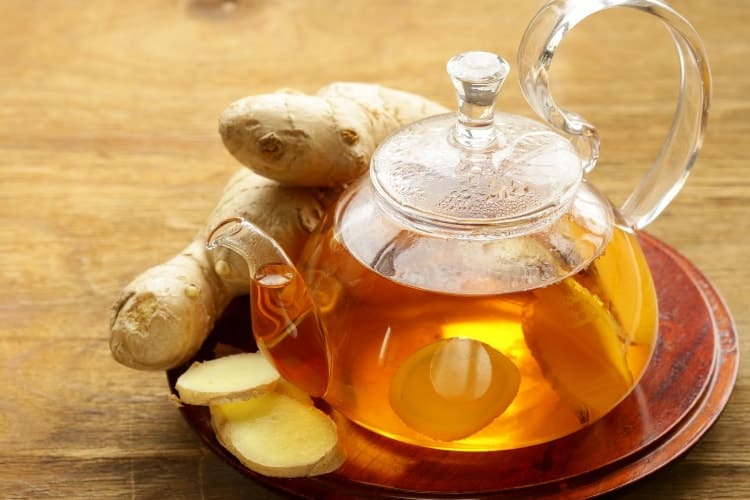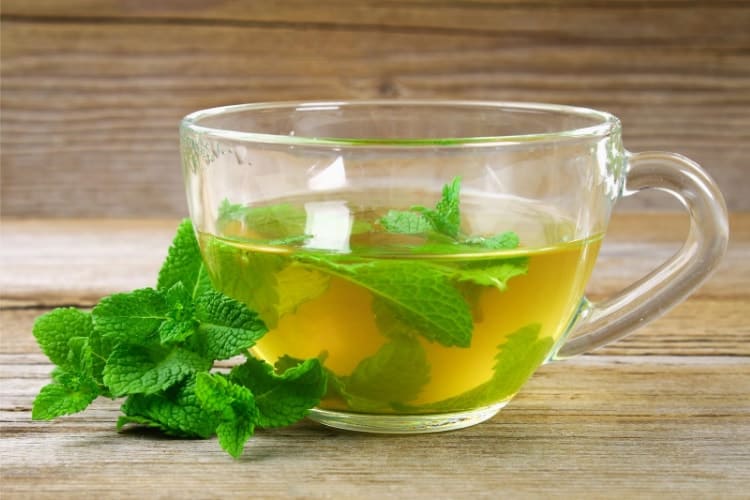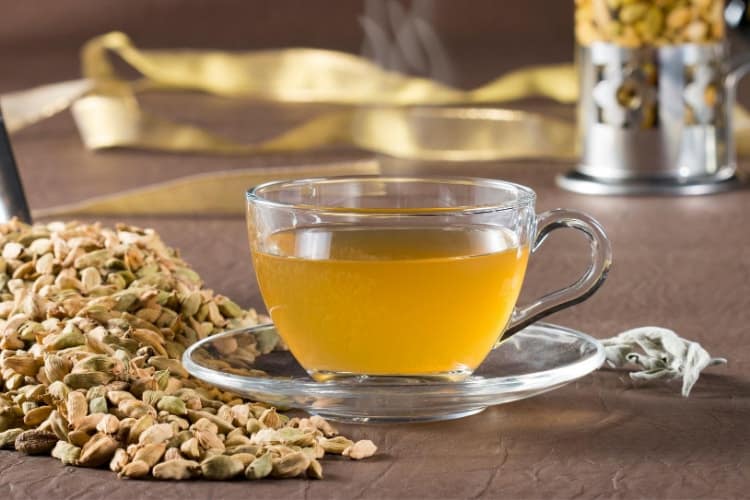Most herbs provide a significant level of anti-inflammatory and antioxidant activity, which makes them very helpful for naturally relieving period pain. In this article we’re going to look at the ten best teas for menstrual cramps. As we go through this list of teas you’ll notice that they also help with other pms or period-related symptoms such as bloating, heavy bleeding and anxiety.
Now, before we dive into the list of teas, it’s important to note that painful periods are usually the result of inflammation. And one of the major contributors to that inflammation are hormones called prostaglandins.
When there’s an excess of prostaglandins, that can lead to more frequent, and more intense, uterine contractions.
So, in order to get relief from these painful contractions, we need teas that:
- reduce pain.
- fight inflammation.
- relax muscles.
Now, without further delay, let’s have a look at some cramp-busting teas!
Note: this post contains affiliate links and I earn a commission (at no additional cost to you) if you use them to make a purchase.
1. Cramp Bark Tea
With a name like “cramp bark,” you know this herb is a must-have for your cycle.
Cramp bark is used for various types of pain or cramps, including menstrual pain, arthritis and even pregnancy-related pain.
This herb is said to work by reducing muscle spasms; specifically uterine muscle spasms.
In addition, cramp bark is also effective for excess fluid retention, which is a common PMS symptom.

Research shows that when it comes to fighting menstrual pain, ginger is just as effective as NSAIDs (nonsteroidal anti-inflammatory drugs) like ibuprofen and mefenamic acid.
Ginger’s ability to reduce pain is all thanks to its anti-inflammatory compounds which include gingerol, shogaol, paradol and zingerone.
In fact, some studies show that taking as little as ⅛ – ¼ tsp of ginger 3 times a day is enough to ease the intensity and duration of cramps.
Furthermore, ginger also provides relief from other PMS symptoms like nausea and headache.
Learn more (and get my ginger tea recipe):
3. Cinnamon Tea
As
a natural anti-inflammatory spice, cinnamon has been shown to lower
menstrual pain, heavy bleeding, nausea and vomiting…all without causing
any negative side effects.
And what’s even better is that you don’t need a whole lot of cinnamon to see results.
As a matter of fact, some studies used just 420mg (0.08 tsp)!
And in case you’re wondering how high you can go, up to 1 tsp a day is generally considered safe (unless you have a special allergy or sensitivity to cinnamon).
4. Turmeric Tea
When it comes to reducing pain and inflammation, turmeric is one of the best herbs you can get your hands on.
There are various ways in which turmeric is able to provide relief from painful periods.
For example, turmeric can:
- regulate the production of pro-inflammatory prostaglandins.
- fight off systemic inflammation thanks to its high antioxidant content.
- inhibit reactions that involve NF-kappa-Beta (NF-κΒ). NF-κΒ is a protein complex that is involved in the development of inflammation. And the activation of NF-κΒ is seen in various pain conditions like migraines and arthritis. So, by blocking reactions that involve this protein complex, turmeric is able to lower pain throughout the body.
5. Peppermint Tea

Peppermint is a natural muscle relaxant and it has a cooling effect that is very beneficial for painful periods.
So far, research attributes much of peppermint’s pain-reducing properties to menthol, which is a major constituent of this herb.
In fact, a 2016 study compared the effects of mint extract and the prescription drug, mefenamic acid (MA) on period cramps.
And the study found that mint is just as effective as MA.
Furthermore, mint also improves other period-related symptoms like nausea and diarrhea.
6. Chamomile Tea
- Research shows that chamomile acts as an:
- analgesic (pain reliever).
- antispasmodic (stops involuntary muscle spasms).
- anti-inflammatory.
- anxiolytic (anti-anxiety).
Given these properties, chamomile is an excellent natural remedy for cramps and PMS!
In addition, chamomile tea helps regulate the actions of dopamine and serotonin, which has a huge impact on our mood.
And just like many of the herbs we’ve already looked at, chamomile has been shown to be just as effective as the prescription drug mefenamic acid.
7. Stinging Nettle Leaf Tea
Stinging nettle is like an all-in-one emergency care kit for all things related to women’s health.
Not only does nettle have anti-inflammatory properties that can help with cramps, but it’s also rich in iron (helpful for anemia).
In addition, nettle could help with a heavy flow since it contains vitamin K (which is necessary for blood clotting).
Furthermore, nettle seems to have anti-inflammatory properties, blood-sugar regulating properties and might be helpful for protecting the liver.
8. Red Raspberry Leaf Tea
Red raspberry leaf is a “woman’s herb” that benefits women at various stages of life.
In particular, red raspberry leaf contains fragarine, a compound that tones the pelvic area.
This tonifying action seems to be one of the main reasons why women have historically used raspberry leaf for cramps and PMS.
In addition, red raspberry leaf is a good source of iron, which can help prevent anemia.
9. Dandelion Tea
Even
though menstrual cramps are mainly due to prostaglandin hormones, other
toxins and hormonal imbalances can also contribute to inflammation.
One organ that plays an important role in detoxification and hormone balance is the liver.
When your liver is in good health, it is able to do it’s main job, which is to purify the blood.
To support the liver, dandelion is one of the most effective herbs that you can use.
It’s believed that dandelion’s main benefit comes from the fact that it increases the flow of bile.
Bile, which is made in the liver, helps enzymes that are responsible for filtering the blood and removing impurities.

Fennel seeds have traditionally been used around Mediterranean as a home remedy for period cramps.
And scientific research now confirms that fennel is indeed effective at relieving menstrual discomfort.
And even when compared with a prescription pain drug, fennel is just as effective.
Now, having said that, please note that some women can experience about 10% more bleeding when using fennel.
So, if you select fennel as your ideal tea to drink during your period, make sure to start slow and monitor your body’s reaction to it.
BEST HERBAL TEA BLEND FOR PERIOD PAIN
There are two main ways to enjoy herbal teas for menstrual pain:
- buy the individual teas and blend them at home.
- get a ready-made blend that contains these herbs in the right ratios.
Of the two options above, a ready-made blend is definitely the quickest and most convenient.
And one blend that I highly recommend is Healthy Cycle from Traditional Medicinals.
It contains many of the herbs we covered in this article, such as:
- Red raspberry leaf
- Stinging nettle
- Ginger
- Dandelion
- Chamomile
I also like this blend because the parent company, Traditional Medicinals, was started by famed herbalist, Rosemary Gladstar, in the early 1970s.
Now, even though Gladstar is no longer involved in formulating the blends, the company has continued to maintain the high production standards that she set.
So, personally, when it comes to convenience and quality, Traditional Medicinals is my top choice.
You can get the Healthy Cycle tea here from their Amazon shop.
FAQs ABOUT THE BEST TEAS FOR MENSTRUAL CRAMPS
Is green tea good for menstrual cramps?
Because green tea is full of antioxidants, it can be very helpful for fighting off the inflammation that contributes to period pain. Furthermore, green tea’s anti-inflammatory properties help to support overall hormone balance (which is necessary for a healthy menstrual cycle).
To get the most out of green tea you can do a standard tea infusion, or you can use matcha powder (ground up green tea leaves).
To learn more about matcha be sure to read this post on the benefits of matcha for hormone balance.
What drinks help period cramps?
Aside from herbal teas, smoothies are also very helpful for period pain. Simply combining anti-inflammatory fruits like blueberries and pineapple, with detox-friendly leafy greens (like spinach) can help.
For a complete recipe that you can start using today, be sure to read this article on how to make a smoothie for period cramps.
CONCLUSION
Even though period cramps can be incredibly disruptive and intrusive you can find relief through natural remedies like teas.
As with all natural methods, it’s important to be consistent with teas.
Think of them as food and incorporate them into your daily routine so that you develop the habit of drinking them.
For example, you can give yourself a few minutes of silence every day where you find a quiet space and just sip on tea.
It’s a simple way to practice self care, quiet your mind and nourish your body all at once.
I hope this post was helpful and as always, feel free to drop your questions or other feedback in the comments section.
